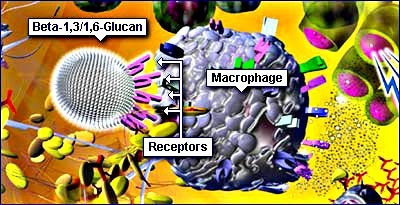ยีสต์บีตากลูแคน: อาหารเสริมระบบภูมิต้านทาน
Main Article Content
Abstract
Arun Chanchaichaovivat
รับบทความ: 15 เมษายน 2553; ยอมรับตีพิมพ์: 12 พฤษภาคม 2553
บทคัดย่อ
บีตากลูแคนจัดเป็นสารประกอบพอลิแซคคาไรด์ (polysaccharide) ที่มีหน่วยย่อยของน้ำตาลดีกลูโคส (D-glucose) เชื่อมต่อกันด้วยพันธะบีตาไกลโคซิดิก (β-glycosidic bonds) ซึ่งบีตากลูแคนที่พบในธรรมชาติมีหลายกลุ่มด้วยกัน โดยมีลักษณะแตกต่างกันไปขึ้นอยู่กับคุณสมบัติทางเคมีและโครงสร้างสามมิติของบีตากลูแคนชนิดนั้นๆ โดยทั่วไปบีตากลูแคนพบได้ในรำข้าว สาหร่ายทะเล ผนังเซลล์ของฟังไจ และพบในแบคทีเรียบางชนิด ซึ่งปัจจุบันได้มีการสกัดบีตากลูแคนจากสิ่งมีชีวิตหลายชนิดเพื่อนำมาใช้ประโยชน์ในด้านต่างๆ เช่น ผลิตเป็นอาหารเสริมสุขภาพ เป็นแหล่งไฟเบอร์ ผสมในเครื่องสำอาง และเป็นสารเพิ่มผิวสัมผัส (texturing agents) โดยเฉพาะอย่างยิ่งการนำบีตากลูแคนจากผนังเซลล์ยีสต์มาใช้เป็นสารเพิ่มภูมิต้านทานให้กับมนุษย์นับว่ามีความสำคัญมากขึ้น เนื่องจากมีโรคที่เกิดขึ้นใหม่อยู่ตลอดเวลาหรือยังคงพบโรคที่มีความรุนแรงรักษาได้ยาก เช่น โรคมะเร็ง โรคเอดส์ โรคไข้หวัดนก ซึ่งโรคเหล่านี้มักเกี่ยวข้องกับระบบภูมิคุ้มกันของร่างกายที่มีความบกพร่องอยู่ด้วย ดังนั้นการเสริมสร้างภูมิต้านทานให้กับผู้ที่เสี่ยงต่อการติดเชื้อหรือผู้ที่มีร่างกายอ่อนแอด้วยอาหารเสริมจึงมีส่วนช่วยรักษาโรคและบรรเทาอาการเจ็บป่วยได้อีกทางหนึ่ง
คำสำคัญ: ยีสต์ บีต้ากลูแคน อาหารเสริม ระบบภูมิต้านทาน
Abstract
β-glucan is a polysaccharide compound composing of D-glucose monomer linked with β-glycosidic bond. There are many groups of β-glucans that found in nature. Their chemical characteristics and three-dimensional structure are different in each β-glucan. In general, β-glucans are found in plants, rice brand, sea weed, fungal cell wall and some bacteria. At present, β-glucans can be extracted from various organisms to use in many advantages such as a fiber source in healthy food, cosmetic products and texturing agents. Particularly, β-glucan from yeast cell wall is used to increase human immune responses since new diseases have occurred, and some dangerous diseases, e.g., cancer, AIDS, bird flu are still found. All related diseases are incorporated with the disorder immune system. Therefore, to increase immunity for anybody who are high risks to infectious diseases or immunity-disorders are a way to cure and relief their symptoms.
Keywords: Yeast, β-glucan, Healthy food, Immune system
Downloads
Article Details

This work is licensed under a Creative Commons Attribution-NonCommercial 4.0 International License.
References
สำนักงานนวัตกรรมแห่งชาติ. (2553). เปิดโลกนวัตกรรมไทย: การผลิตเบต้ากลูแคนจากยีสต์. Retrieved April 2, 2010, from Website: http://products.in nook.com/product.php?pid=21
Babineau, T. J., Marcello, P., Swails, W, Kenler A., Bistrian, B., and Forse, R. A. (1994). Randomized phase I/II trial of a macrophage-specific immuno-modulator (PGG-glucan) in high-risk surgical patients. Annals Surg. 220(5): 601-609.
Beta Glucan Research Organization. (2009). Beta glucan research - Saccharomyces cerevisiae. Retrieved March 21, 2010, from Website: http://betaglu can.org
Bogwald, J., Johnson, E., and Seljelid, R. (1982). The cytotoxic effect of mouse macrophages stimulated in vitro by a beta-1,3-D-glucan from yeast cell walls. Scand. J. Immunol. 15(3): 297-304.
Burge, H. (2010). Health effects of glucans. The Environmental Reporter, 8(6), 1-5. Retrieved March 10, 2010, from Website: http://www.emlab.com/s/sampling/env-report-06-2010.html
Chan, G. C. F., Chan, W. K., and Sze, D. M. Y. (2009). The effects of B-glucan on human immune and cancer cells. J. Hematol. Oncol. 2(25). DOI: 10.1186/1756-8722-2-25.
Cheung, N. K, Modak, S., Vickers, A., and Knuckles, B. (2002). Orally administered betaglucans enhance anti-tumor effects of monoclonal antibodies. Cancer Immunol. Immunother. 51(10): 557-564.
Cramer, D. E., Allendorf, D. J., Baran, J. T., Hansen, R., Marroquin, J., Li, B., et al. (2006). Beta-glucan enhances complement-mediated hematopoietic recovery after bone marrow injury. Blood 107 (2): 835-840.
Czop, J. K., and Austen, K. F. (1985). Generation of leuko-trienes by human monocytes upon stimulation of their beta-glucan receptor during phagocytosis. Proc. Natl. Acad. Sci. USA 82(9): 2751-2755.
Dellinger, E. P., Babineau, T. J., Bleicher, P., Kaiser, A. B., Seibert, G. B., Postier, R. G., et al. (1999). Effect of PGG-glucan on the rate of serious postoperative infection or death observed after high-risk gastrointestinal operations. Betafectin Gastrointestinal Study Group. Arch. Surg. 134(9): 977-983.
Demir, G., Klein, H. O., Mandel-Molinas, N., and Tuzuner, N. (2007). Beta glucan induces proliferation and activation of monocytes in peripheral blood of patients with advanced breast cancer. Int. Immunopharmacol. 7(1): 113-116.
Fuller, R. (2010). The importance of innate immune function in disease management and pre-vention: 1-3, 1-6 beta glucan supplement-ation advice. Retrieved May 3, 2010, from Website: http://www.doveclinic.com/downloads/ .../Immiflex DoveWebsiteInfo.pdf
Hong, F., Yan, J., Baran, J. T., Allendorf, D. J., Hansen, R. D., Ostroff, G. R., et al. (2004). Mechanism by which orally administered β-1,3-glucans enhance the tumoricidal activity of antitumor monoclonal antibodies in murine tumor models. J. Immunol. 173(2): 797-806.
Kernodle, D. S., Gates, H., and Kaiser, A. B. (1998). Prophylactic anti-infective activity of poly-[1-6-beta-D-glucopyranosyl-[1-3]-beta-D-glucoprya-nose glucan in a guinea pig model of staphylo-coccal wound infection. Antimicrob. agents chemother. 42(3): 545-549.
Kogan, G., Stasko, A., Bauerova, K., Polovka, M., Soltes, L., Brezova, V., and Navarova, J. (2005). Anti-oxidant properties of yeast (1,3)-B-D-glucan studied by electron paramagnetic resonance spectroscopy and its activity in the adjuvant arthritis. Carbohydrate Polymers 61(1): 18-28.
Lee, J. N., Lee, D. Y., Ji, I. H., Kim, G. E., Kim, H. N., Sohn, J., Kim, S., and Kim, C. W. (2001). Purification of soluble beta-glucan with immune-enhancing activity from the cell wall of yeast. Biosci. Biotechnol. Biochem. 65(4): 837-841.
Onderdonk, A. B., Cisneros, R. L., Hinkson, P., and Ostroff, G. (1992). Anti-infective effect of poly-beta 1-6-glucotriosyl-beta 1-3-glucopyranose glucan in vivo. Infect. Immun. 60 (4): 1642-1647.
Ooi ,V. E., and Liu, F. (2000). Immunomodulation and anti-cancer activity of polysaccharide-protein complexes. Curr. Med. Chem. 7(7): 715-729.
Patchen, M. L., MacVittie, T. J., and Wathen, L. M. (1984). Effects of pre- and post-irradiation glucan treatment on pluripotent stem cells, granulocyte, macrophage and erythroid progenitor cells, and hemopoietic stromal cells. Experientia 40(11): 1240-1244.
Petruczenko, A. (1984). Glucan effect on the survival of mice after radiation exposure. Acta physio-logica Polonica 35(3): 231-236.
Specialty Biotech. (2005). Innovacan. Retrieved April 20, 2010, from Web site: http://www.sbtthai.com/ product_innovacan.html
Thompson, I. M, Spence, C. R., Lamm, D. L., and DiLuzio, N. R. (1987). Immunochemotherapy of bladder carcinoma with glucan and cyclophos-phamide. Am. J. Med. Sci. 294(5): 294-300.
Vetvicka, V., Thornton, B. P., and Ross, G. D. (1996). Soluble beta-glucan polysaccharide binding to the lectin site of neutrophil or natural killer cell complement receptor type 3 (CD11b/CD18) generates a primed state of the receptor capable of mediating cytotoxicity of iC3b-opsonized target cells. J. Clin. Invest. 98(1): 50-61.
Wasser, S. P., and Weis, A. L. (1999). Therapeutic effects of substances occurring in higher Basidiomycetes mushrooms: A modern perspective. Crit. Rev. Immunol. 19(1): 65-96.
